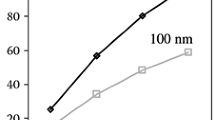Abstract
Nanocomposites based on AgI and Al2O3 have been obtained using the techniques of chemical condensation, mechanical treatment, and crystallization. The size of the particles is estimated using the scanning-electron-microscopy technique. After mechanical treatment and crystallization, the AgI composite is composed of nanoparticles of silver iodide, which are localized in the shells of nanocrystalline aluminum oxide. The size of the particles and the thickness of the shells are determined. The results are discussed based on considerations that describe the microscopic mechanisms responsible for the formation of silver iodide nanocrystals in the process of mechanical treatment and crystallization. It is shown that the shape and structure of the composite nanoparticles change depending on the method and conditions of their production.
Similar content being viewed by others
References
Eggins, B.R., Chemical Sensors and Biosensors, New York: Wiley, 2002. Translated under the title Khimicheskie i biologicheskie sensory, Moscow: Tekhnosfera, 2005.
Wiegleb, G., Industrielle Gassensorik, Berlin: Expert, 1988. Translated under the title Datchiki, Moscow: Mir, 1989.
Göpel, W., New Materials and Transducers for Chemical Sensors, Sens. Actuators, B, 1994, vols. 18–19, pp. 1–21.
Gas’kov, A.M. and Rumyantseva, M.N., Materials for Solid-State Gas Sensors, Inorg. Mater., 2000, vol. 36, no. 3, pp. 293–301.
Davydov, S.Yu., Moshnikov, V.A., and Tomaev, V.V., Adsorbtsionnye yavleniya v polikristallicheskikh poluprovodnikovykh sensorakh (Adsorption Phenomena in Polycrystalline Semiconductor Sensors), St. Petersburg: Saint Petersburg Electrotechnical University “LETI,” 1988.
Yaroslavtsev, A.B., Khimiya tverdogo tela (Chemistry of the Solid State), Moscow: Nauchnyi Mir, 2009.
Liang, C.C., Conduction Characteristics of the Lithium Iodide-Aluminum Oxide Solid Electrolytes, J. Electrochem. Soc., 1973, vol. 120, no. 10, pp. 1289–1292.
Maier, J., Thermodynamic Aspects and Morphology of Nano-Structured Ion Conductors: Part I. Aspects of Nanoionics, Solid State Ionics, 2002, vols. 154–155, pp. 291–301.
Maier, J., Defect Chemistry and Ion Transport in Nanostructured Materials: Part II. Aspects of Nanoionics, Solid State Ionics, 2003, vol. 157, pp. 327–334.
Maier, J., Nano-Sized Mixed Conductors: Part III. Aspects of Nanoionics, Solid State Ionics, 2002, vol. 148, pp. 367–374.
Sata, N., Jin-Phillipp, N.Y., Eberl, K., and Maier, J., Enhanced Ionic Conductivity and Mesoscopic Size Effects in Hetero-Structures of BaF2 and CaF2, Solid State Ionics, 2002, vols. 154–155, pp. 497–502.
Lee, J.-S., Adams, St., and Maier, J., A Mesoscopic Heterostructure as the Origin of the Extreme Ionic Conductivity in AgI: Al2O3, Solid State Ionics, 2000, vols. 136–137, pp. 1261–1266.
Aniya, M. and Kawamura, J., Medium-Range Structure and Activation Energy of Ion Transport in Glasses, Solid State Ionics, 2002, vols. 154–155, pp. 343–348.
Ukshe, E.A. and Bukun, N.G., Tverdye elektrolity (Solid Electrolytes), Moscow: Nauka, 1977.
Uvarov, N.F., Stabilization of Amorphous Phases in Ion-Conducting Composites, Russ. J. Appl. Chem., 2000, vol. 73, no. 6, pp. 1030–1035.
Uvarov, N.F. and Boldyrev, V.V., Size Effects in the Chemistry of Heterogeneous Systems, Usp. Khim., 2001, vol. 70, no. 4, pp. 970–975.
Uvarov, N.F., Ionics of Nanoheterogeneous Materials, Usp. Khim., 2007, vol. 76, no. 5, pp. 454–473.
Gurevich, Yu.Ya. and Kharkats, Yu.I., Features of the Thermodynamics of Superionic Conductors, Sov. Phys.-Usp., 1982, vol. 25, no. 4, pp. 257–276.
Gusev, A.I., Nanomaterialy, nanostruktury, nanotekhnologii (Nanomaterials, Nanostructures, and Nanotechnologies), Moscow: Nauka, 2007.
Suzdalev, I.P., Nanotekhnologiya: fiziko-khimiya nanoklasterov, nanostruktur i nanomaterialov (Nanotechnology: Physics and Chemistry of Nanoclusters, Nanostructures, and Nanomaterials), Moscow: KomKniga, 2006.
Poole, C.P., Jr. and Owens, F.J., Introduction to Nanotechnology, New York: Wiley, 2003. Translated under the title Nanotekhnologii, Moscow: Tekhnosfera, 2006.
Avakumov, E.G., Mekhanicheskie metody aktivatsii khimicheskikh protsessov (Mechanical Methods for Activation of Chemical Processes), Novosibirsk: Nauka, 1986.
Butyagin, P.Yu., Problems in Mechanochemistry and Prospects for Its Development, Usp. Khim., 1994, vol. 63, no. 12, pp. 1031–1043.
Enikolopov, N.S., Solid-Phase Chemical Reactions and New Technologies, Usp. Khim., 1991, vol. 60, no. 3, pp. 586–594.
Boldyrev, V.V., Mechanochemistry and Mechanical Activation of Solids, Usp. Khim., 2006, vol. 75, no. 3, pp. 203–216.
Borisenko, V.E., Vorob’eva, A.I., and Utkina, E.A., Nanoelektronika (Nanoelectronics), Moscow: Binom, 2009.
Rambidi, N.G. and Berezkin, A.V., Fizicheskie i khimicheskie osnovy nanotekhnologii (Physical and Chemical Foundations of Nanotechnology), Moscow: Fizmatlit, 2009.
Powder Diffraction File PDF-2 Release 2012. http://www.icdd.com/products/pdf2.htm.
Bal’makov, M.D., On the Microscopic Mechanism of Formation of Nanostructures in Condensed Media, Glass Phys. Chem., 2011, vol. 37, no. 2, pp. 157–160.
Tomaev, V.V., Tver’yanovich, Yu.S., Bal’makov, M.D., Zvereva, I.A., and Missyul’, A.B., Ionic Conductivity of (As2Se3)1 − x (AgHal)x (Hal = I, Br) Nanocomposites, Glass Phys. Chem., 2010, vol. 36, no. 4, pp. 455–462.
Author information
Authors and Affiliations
Corresponding author
Additional information
Original Russian Text © V.V. Tomaev, Yu.S. Tver’yanovich, M.D. Bal’makov, E.G. Zemtsova, 2013, published in Fizika i Khimiya Stekla.
Published on the materials of All-Russia Conference “Sol-Gel, Synthesis and Investigations into Inorganic Compounds, Hybrid Functional Materials, and Dispersed Systems.” Russia, St. Petersburg, November 22–24, 2010.
Rights and permissions
About this article
Cite this article
Tomaev, V.V., Tver’yanovich, Y.S., Bal’makov, M.D. et al. Nanocomposites based on silver iodide and aluminum oxide. Glass Phys Chem 39, 94–99 (2013). https://doi.org/10.1134/S1087659613010136
Received:
Published:
Issue Date:
DOI: https://doi.org/10.1134/S1087659613010136




